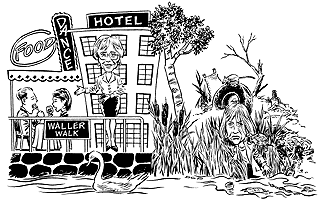Waller, Waller Everywhere
Is Griffith Up Waller Creek Without a Paddle?
By Kayte VanScoy, Fri., Jan. 23, 1998
|
|
I've been saying Waller Creek would have its day any day now, every day since 1977," jokes real estate developer Perry Lorenz. His remark was in response to Councilmember Beverly Griffith's announcement last Thursday of a new push to revitalize the creek, which snakes through the city just west of I-35. Waller starts near Koenig Lane, cuts through Hyde Park, the University of Texas, Waterloo Park, and several highly trafficked business areas before finally emptying into Town Lake. The creek has always had the potential to be a corridor of beauty through an otherwise heavily paved area of town, but has instead become a forgotten and neglected ditch, frequented by transients, and full of human waste and trash. But now, with the recent drive to not only revamp downtown but make it Austin's crowning jewel of commerce and community, ignoring Waller Creek is simply no longer an option. Unfortunately, however, because Waller is in the 100-year flood plain, any effort to focus resources on the creek must first begin as an expensive engineering project. At nearby Shoal Creek - the site of the deadly 1981 Memorial Day flood that caused eight fatalities - reworking the creek bed and widening Shoal's banks was sufficient to continue its use primarily as a hike and bike route. However, the more urbanized plans for Waller necessitate more serious mitigation - catching most of the creek at 15th Street and channeling it into a $24 million tunnel to the river, while keeping Waller's level stable. Only then - with predictable water levels regardless of weather - investment in beautifying Waller, and more importantly in encouraging commerce along its banks, can finally begin.
Just as Waller cuts through the heart of Austin, its clean-up cuts straight to the heart of some of the most pressing issues currently on the city's plate. No discussion of Waller is complete without first hashing through water quality, the convention center expansion, the increase of residential space downtown, the Mexican American Cultural Center, public-private partnerships, and homelessness, to name just a few thorny issues. Although Waller in its current squalor is no big asset to Austin, the economy is booming without Waller's revitalization. To gather support for investment in the project, the city council will have to convince citizens to leap beyond the status quo and shoot for the urban-investment moon. Not only will council have to show that the public needs to do this for our fair city, but it will have to convince taxpayers that it's possible to overcome the 30 years of inertia that has plagued Waller Creek. The city's history of failed attempts to save Waller from itself will no doubt drag on the public's patience.
After a deadly flood in the first part of this century, Waller first blipped onto Austin's radar in 1969, when student environmentalists fought to save trees along its banks on the UT campus. In 1976, a plan for the creek was presented to the nation as Austin's "bicentennial gift," but nothing beyond a few pathways were constructed. In the mid-Eighties, a Texas-style political shootout over a doomed plan for a municipal office complex at the foot of the creek left business and political interests alike weary of discussing Waller's future. More recently, a failed attempt to legalize riverboat gambling refocused attention on Waller as an urban asset. Councilmember Jackie Goodman took up the issue in 1995, spurring the commission of the $180,000 Loomis report in 1996 on development along the creek. Finally, in November 1997, a resolution regarding Waller's redevelopment was included in a package of resolutions connected to the city's investment in downtown housing. "Part of the reason to get it done is it's just time to get it done," says Mayor Kirk Watson. "I mean, bicentennial gift to the nation? This ain't no rush."
Nevertheless, when Beverly Griffith stepped up to the plate last week to launch another of her patented charette-style community planning processes for a "civilized wilderness" along Waller Creek, the entire council seemed taken aback. Why? Apparently, more than a few toes were stomped by Griffith's last-minute rush of her announcement onto the agenda. After all, it's Goodman who was responsible for starting the recent creek cleanup push - she even included Waller's development in her campaign platform. That Griffith is coming along now to announce plans of her own may seem a bit grabby, but there's a reason for her thunder-stealing move. She is jumping in to enact what her aide calls a "one-woman boondoggle-prevention program." One element that Griffith's proposal has that Goodman's doesn't is the demand that private property owners who stand to gain from improvements to the creek ought to shoulder the financial burden. Griffith's insistence that private landowners along the creek contribute a significant percentage of the funds to build the tunnel and maintain the creek obviously doesn't sit well with the Downtown Austin Alliance and developer types. Nevertheless, Griffith seems pumped about her proposal to gather together the stakeholders and get busy dreaming up a community vision. "Was there someone out in front of [the issue] before? If so, who? And what were they doing?" Griffith asks, denying any knowledge of breaking council's usual vision-sharing etiquette.
Developer Lorenz, who owns land being eye-balled for a luxury convention center hotel at the foot of Waller, has an answer to Griffith's questions. Lorenz was initially recruited by Griffith to drum up support for private investment in the tunnel, but when he found little encouragement among business owners for such a plan, some sources say, Griffith pledged herself as his arch-enemy. Griffith insists this is not the case, painting Lorenz's contribution in glowing terms like "helpful" and "loyal," and calling him a "sustainer in the project." Lorenz does not reciprocate the feeling, however. "This Waller Creek thing wouldn't be alive if it weren't for Jackie Goodman," he claims, and many city hall insiders agree. Goodman favors finding an alternative method - such as increasing the bed tax or forming a Tax Increment Financing district (TIF) - to fund the tunnel's construction. Griffith, meanwhile, is now arguing that no financing options should be discussed at all until her charette is completed.
The property owners, meanwhile, are busy banding together, likely for the safety in numbers which this political tug-of-war might eventually require. They are already balking at Griffith's call for "the folks who would be directly impacted the most in terms of their own net worth and net income" to pony up, and began meeting Tuesday evening to craft a response.
"That is so naïve that it's ridiculous," says Lorenz, regarding Griffith's assertion that the tunnel will mean millions to the property owners. He points out that years of struggling against flooding and neglect, not to mention the increase they will pay in property tax when the improvements are realized, more than entitle them to city-funded infrastructure along the creek. When presented the argument for city funding, Griffith merely poses a philosophical question: "Who is the city?" What Griffith is implying is that the property owners are, to some degree, part of the city's power structure, that they benefit from it, and that they should invest in it.
And she has a point. Mac Pike, president of Sutton Properties, which owns the two Reddy Ice lots along the creek at Ninth and 10th streets, admits that he is waiting for the city to move before he develops his lots more profitably. "Part of it depends on what happens with the creek. If the tunnel gets built it will be on a much faster track," he says, though he admits that he doesn't want the tunnel coming out of his pocket.
But while business owners don't seem averse to contributing to maintenance of the land once the tunnel is built, most are angry at being asked to invest millions in something they believe will only indirectly benefit them. "I think that it's the job of the government to provide for orderly development, and that doesn't seem to happen here a lot," says John Scott, partner in Stubb's Bar-B-Q on the creek at Eighth Street. "We're very much willing to participate, but I don't particularly want to get penalized for a development that doesn't directly affect us."
Most of the council, at least, seems to be listening to the property owners. Watson, Goodman, and Gus Garcia have already crafted a resolution for this Thursday's agenda which will set the ball in motion to fund the tunnel and the expansion of the convention center through a TIF and a two-cent increase in the bed tax, without any increase in sales or property taxes for the project. However, the resolution also directs the city manager to use the TIF - that's property owners' dollars - to fund "additional projects to redevelop the southeast portion of downtown." That means the Mexican American Cultural Center, the revamping of Palm Park, and other projects which club and restaurant owners may not be too keen on paying for. If Griffith cannot be brought into line before the council convenes, she will very likely be the sole vote against the resolution.
Voting Rights
Mayor Watson has not put away his prospecting equipment just yet. Now he's eyeing Del Valle for the next stage of annexation. Watson says he feels strongly about annexing the heavily minority-populated Del Valle area from an "equity standpoint." Watson says the proposal for a limited-purpose annexation phased in over seven years was not part of the city's presentation at the U.S. Department of Justice, when the city defended the impact of the recent annexations on minority voting rights. But considering that Justice did ask about future annexation plans, the Del Valle move probably wouldn't hurt...
This Week In Council
The budget for the newly annexed areas is already on the agenda, kudos to city staff. Garcia wants the city to help fund the Mexic-Arte art gallery and Daryl Slusher wants to find a way to put recycling bins near public trash cans.
Got something to say on the subject? Send a letter to the editor.









